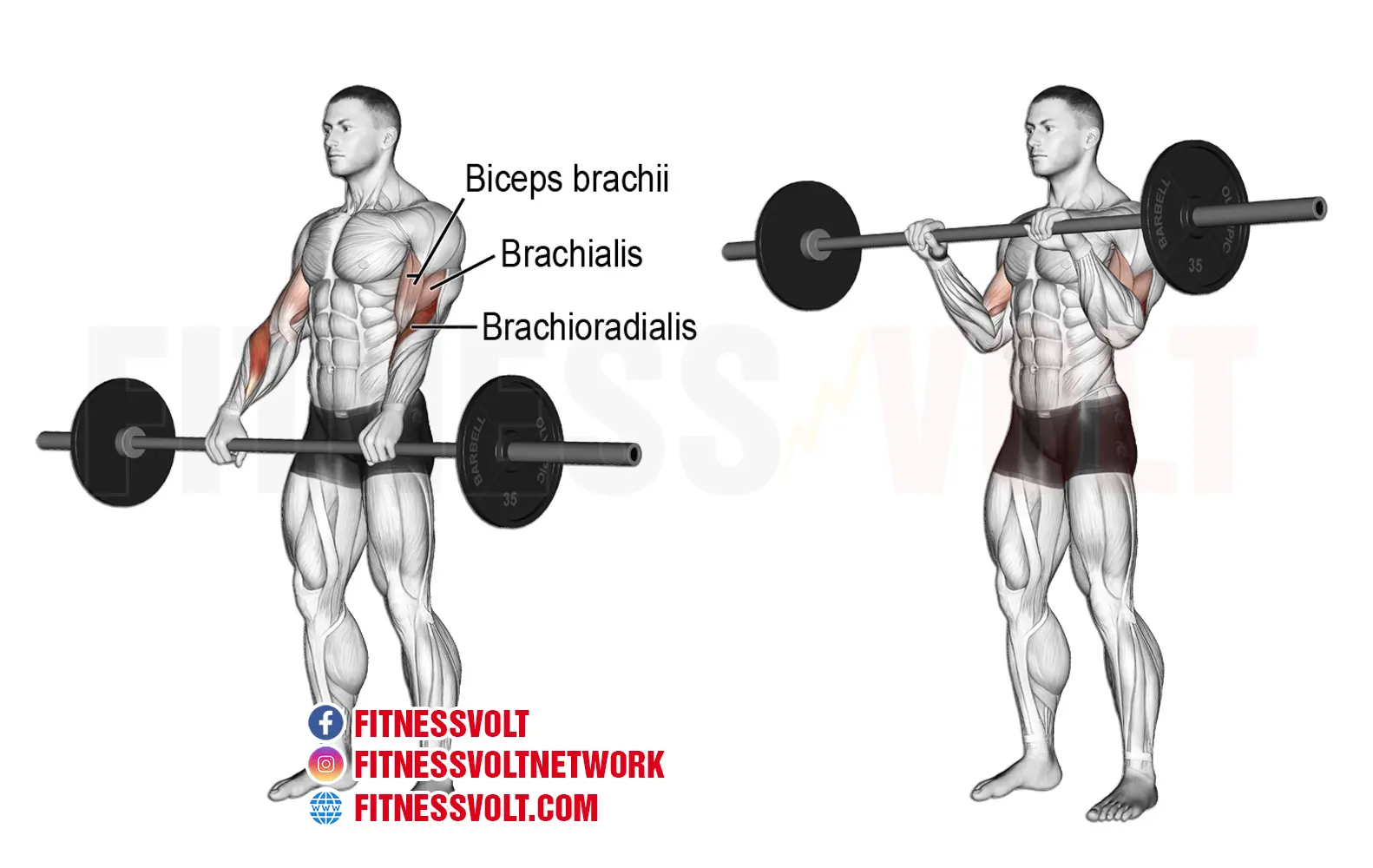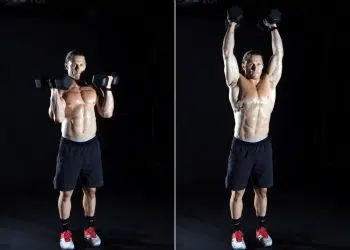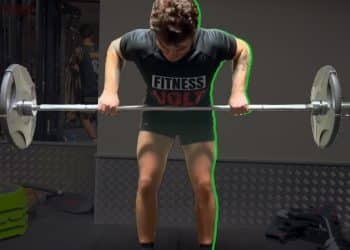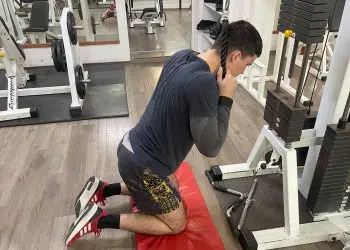The barbell reverse curl is a non-negotiable component of arm training. Sure, a standard barbell curl will still work the same muscles, but a reverse curl variation hits certain muscles a little better. That’s because anatomically, hand position can determine which muscles are more active during specific movements (we’ll get more into that shortly).
The barbell reverse is one of the best arm builders that you can utilize to gain impressive size. And we put together a little guide to help you better incorporate it into your training to ensure that you don’t leave gains on the table.
Here’s a guide to the barbell reverse curl…
In This Exercise:
- Target Muscle Group: Brachioradialis, brachialis, biceps
- Type: Hypertrophy & Strength
- Mechanics: Isolation
- Equipment: Barbell
- Difficulty: Beginner
Muscles Worked
The barbell reverse curl works three muscles: The brachioradialis, brachialis, and biceps. However, the brachioradialis has a mechanical advantage over the biceps in this exercise due to the supinated hand position. So, this exercise is best used when the focus is maximizing the activation of this muscle.
Here’s some anatomy on these muscles…
Level Up Your Fitness: Join our 💪 strong community in Fitness Volt Newsletter. Get daily inspiration, expert-backed workouts, nutrition tips, the latest in strength sports, and the support you need to reach your goals. Subscribe for free!
Brachioradialis
The brachioradialis is a forearm muscle located on the lateral or knuckle side of the lower arm below the elbow, although it crosses the elbow joint. Its function is to bend the elbow and rotate the forearms in either direction. Research has shown that the brachioradialis has a mechanical advantage over the biceps when doing a reverse curl.
If you want to look muscular in a T shirt, then you should focus on training the brachioradialis muscle because it will have a significant effect on your overall arm aesthetics.
Brachialis
Not to be confused with the brachioradialis, the brachialis shares the upper arm with the biceps and triceps. It’s located beneath the outer biceps muscle halfway up the upper arm and crosses the elbow joint. It’s a powerful elbow flexor and forearm supinator/pronator.
Biceps
Bend your elbow and tense your upper arm, the muscle that flexes is the two headed biceps brachii. Consequently, you probably guessed that one of its functions is elbow flexion. But it’s also a strong forearm supinator and pronator which means rotating the palms up and down respectively. Biceps also have a small role i shoulder flexion.
How To Do The Barbell Reverse Curl
The reverse curl is a simple movement to perform. But here are step-by-step instructions to ensure you’re doing it correctly.
- Grip the barbell with hands about shoulder-width apart and palms down. Hold the bar down by your thighs with arms extended and elbows tucked close to your sides.
- Take a comfortable stance and look forward.
- Curl the weight up and squeeze, keeping your wrists straight. Do not rest at the top.
- Lower the weight back down but don’t fully extend your arms.
It’s really that simple. However, there are a few common mistakes that people make which not only reduced the effectiveness of the exercise, but that also puts a strain on the wrists.
Here are a few tips to keep in mind.
Tips
- Use light to moderate weights for this exercise. Heavy weights could strain the wrists.
- Try to keep your wrists straight.
- Avoid doing cheat curls with this variation, especially if you’re a beginner.
- Use a thumbless grip for better activation of the forearms muscles and to build a stronger grip.
3 Barbell Reverse Curl Variations
While the barbell reverse curl is a very effective exercise for targeting the arm muscle, it may not be the most ideal for everyone. Not to mention, there are advantages to utilizing different variations of an exercise.
Here are three awesome variations…
Dumbbell reverse curl
The dumbbell reverse curl not only gives you more freedom of movement, it also allows you to train one arm at a time if you so please. Not to mention, if you have a weaker side, you’ll know it after one set, and dumbbells allow you to correct this issue as well.
But you can position your wrists at a more comfortable position that’s more natural which is also beneficial for those who feel that a straight bar limits their performance.
An EZ bar is also a good option in this case as it allows you to angle your wrists which is arguably more comfortable and less stressful on the wrists.
Cable reverse curl
This is one exercise where cables really shine. The reason being is that you have constant tension on the muscles throughout the entire rep range. Many times, people will curl weight to the top and rest and this is not ideal. But cables are always pulling against your forearms which is a real advantage with this exercise.
You also have more options regarding handles and bar attachments.
Preacher reverse curl
Using a reverse preacher curl stand or machine is a great way to really isolate the biceps. The upper arms are fixed against the padding and you’re unable to use momentum (if done properly) which is ideal for keeping the tension on the biceps.
Just make sure not to rest the weight at the top as you want to keep the biceps working. Usually, it’s advised to stop three fourths of the way up to avoid reducing the tension on the biceps.
How To Incorporate The Barbell Reverse Curl Into Your Workout Routine
The barbell reverse curl can be utilized a few different ways other than doing a 3-4 sets with your biceps training. Here are two that we think are great…
Pre-exhaustion– You can do it before biceps training to pre-exhaust the forearms. That way, the biceps will be forced to do most of the work whereas the forearms will be tired out and less involved in the movement.
Finisher – The barbell reverse curl or any of its variations also make for a great finisher. Whether you train biceps, back, or any other muscle group, you can benefit from doing a few sets of this exercise at the end of a session.
Superset
A superset involves performing two different exercises back to back. Want to really pump up your forearms? Do wrist curls and reverse curls in a super set. Another great exercises to pair the reverse curl with is the standard biceps curl or even a triceps exercise such as the cable pushdown.
Wrapping Up
The barbell reverse curl has its place in any workout regime. It’s popular for reason because it yields results, and we hope that this guide will serve you well in your muscle-building endeavors. And remember, there are several different variations that you can include as well which also have their own advantages.
Interested in measuring your progress? Check out our strength standards for Wrist Curl, Barbell Curl, Tricep Rope Pushdown, and more.












